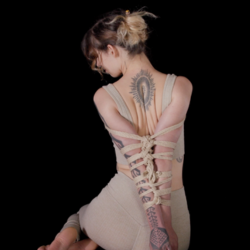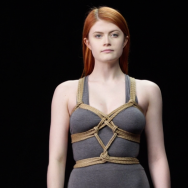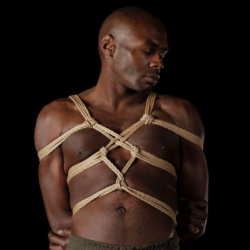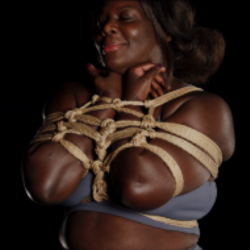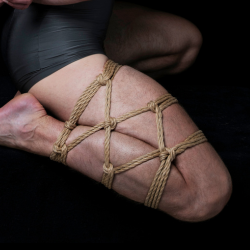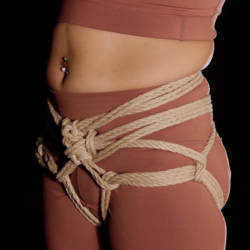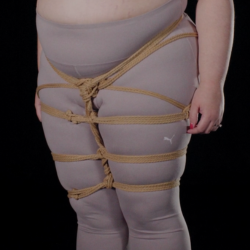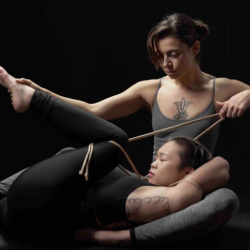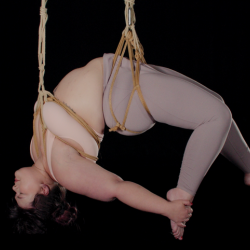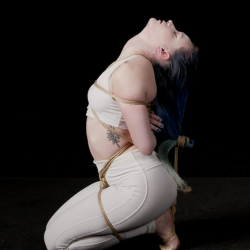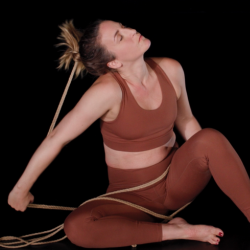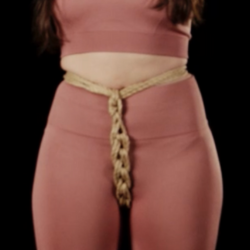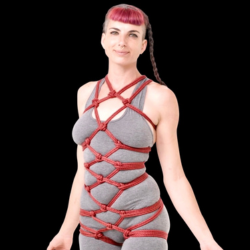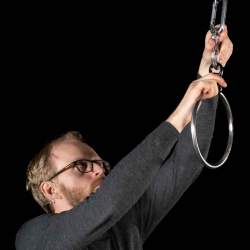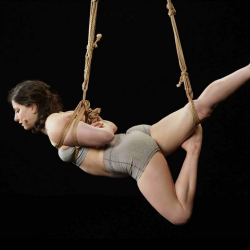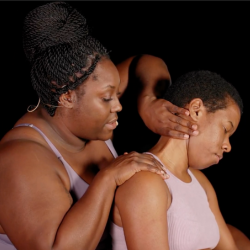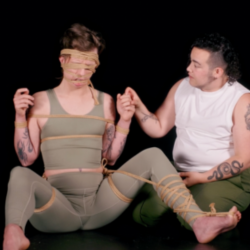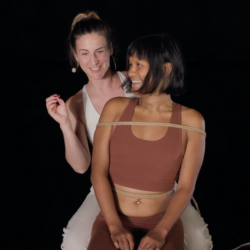EP 53
GANDALF
Gandalf discusses their unique approach to rope, exploring themes of memory, vulnerability, and connection. They share insights on teaching, the emotional impact of touch, and creating spaces for authenticity and intentionality in rope practice.

Gandalf (they/them) is a shibari artist and educator based in Shanghai. They are the founder and organiser of Embodied Flow and the conductor of a local Playback Theatre group. Formerly a cognitive scientist, Gandalf is interested in exploring various forms of embodied thinking with rope being their main medium. Over the past three years, they have been teaching rope to a wide variety of demographics across China, aiming to radically diversify shibari and build safer and more conscious rope communities for queer and women. For them, rope teaches us about "being together". Drawing from their background in psychology and experience across various forms of theatre and dance, Gandalf's workshops often consist of equal measures of movement and rope exercises, and participants are invited to explore a variety of topics from consent, safety, tension, to wild journeys into the philosophy of meaning making, vulnerability, and care. Gandalf has also started the "Kinbaku Theatre" initiative, where they hope to further expand the potential of shibari performances through stage productions. Their writings and talks are featured on Contemporary Queer Chinese Art, DOMUS China, TEDx and more.
[00:00:08] Wren Hello to all my guys, gals and non-binary pals! Welcome to the Shibari Study podcast. I'm your host, Wren. Shibari Study is an online learning resource offering video tutorials for beginners through advanced practitioners. Whether you're brand new to the world of shibari and needing to learn the basics, or a seasoned rigger or rope bottom seeking inspiration to push your practice to new places, there's something for you at shibaristudy.com. Today I'm talking to Gandalf. [0.0s] Gandalf uses they/them pronouns and they're a rope educator based in Shanghai who has a very unique approach to teaching. Gandalf, I'm so excited to talk to you today. How are you?
[00:00:51] Gandalf I'm good. I'm great. It's nice to be here. I'm excited.
[00:00:54] Wren Yeah. Same. You're currently in your apartment. You just moved in. I can see boxes around. And you were talking about when you moved in, since we use our hands with ropes so much, there's a lot of memory associated with touch.
[00:01:10] Gandalf Yes. I think, like– my apologies first, like while we were connecting like, it took me a lot of time to respond. And that's because, like, when I'm in the middle of moving, I'm super depressed. All the time. Because, like, you're going through all this stuff and then you catch, oh, this book or this piece of rope or this piece of fabric, and there's so much memory associated with it, and sometimes you forget you have this. And, like, packing always takes so much time. And then, like, maybe you spent five minutes packing and then you spend 20 minutes ruminating on piece of memory. And so every time I move, it just– like I'm gone. I hate moving so much.
[00:01:54] Wren Me, too. I feel like everyone does. It's so bad. Are you a big journaler, by any chance?
[00:02:02] Gandalf Not at all. Like, I tried, and I had a, I had a journal. Her name was Emily, so I was like, like, every day I would be like, "Dear Emily...". Like, I had her when I was very young, and because I needed a friend to talk to. And... Yeah, at some point it just stopped, I think. And I never picked it up because I feel like it would do a disservice to Emily.
[00:02:31] Wren Why did you name her Emily?
[00:02:36] Gandalf I have no, I have no idea. I think probably some TV show I was watching and someone's name with Emily, and I really liked her. And then I feel like "I want to talk to Emily every day". And so...
[00:02:46] Wren That's so cool. All kids have imaginary friends. I definitely did that as a kid, but I never personified it and put my Emily into a book that I could write to. That's a really cool thing.
[00:03:00] Gandalf Yeah. Yeah. But too bad she couldn't write me back. So at some point, you feel like you're speaking to a void.
[00:03:09] Wren Exactly. Well, how did you get into rope? It sounds like you had a really cool childhood in general. Like, how do you find rope and stuff?
[00:03:23] Gandalf I don't– I don't think cool is the word. I think it was mostly lonely. I didn't play with other kids. I read a lot, so, like, I don't think I had a childhood, really? Like, I was– I think I started being an adult very early, and then when I reached adulthood, I started being a child. And so it's kind of like a Benjamin Button case. And so for rope, I knew I was (…) for as long as I can remember. And, like, there's no, like, incidents, there's no memories, it's just, when I... Yeah, it's just like, whenever I see people being tied up on TV, I get really excited. And so I knew I like it. And then, when I get older, I started to look for images and videos of people being tied up on the internet. And there are a lot of, like, playlist I dedicated to just clips from movies and TV shows of people being kidnaped, abducted, and like a, like, like a lot of, like, recording struggling videos I really enjoyed watching when I was little. And so sometimes I would look at these pictures on forums, like to, like at 1 to 2 in the morning. And before I started doing my homework and so for my parents, they thought, Okay, like, my child really loves studying. Like, I kind of was studying really hard, and they don't finish their homework until in the morning. It was really because I spent a lot of time looking through these pictures online. And to me, I think I found a lot of consolation, because, like, there was really no one to talk to this about with my peers. And I think seeing that there are people who is building these websites, people who have curated and, and went through the trouble like it was like 20 years ago. And so the editing wasn't that convenient, I would assume, right? And they went to all of this trouble, like editing, clipping, uploading with like really slow internet and really made me feel like, Okay, I'm part of something bigger, and there are people like me. And so there's a lot of confirmation from those. And now it's we become more like intellectually mature. Like there's a lot of, like, problems with how these images were represented and circulated. But for a child, I think, it does help in that sense. And I was lucky that I did not see anything that was, I guess, misleading to me? So I was just like, yeah, I still grew up, like, relatively healthy as a teenager.
[00:06:07] Wren As healthy as you can be growing up on the early internet.
[00:06:11] Gandalf Yes.
[00:06:13] Wren It is cool to think about the early internet because it felt like a labor of love in a lot of places. A lot of chat rooms, a lot of people that were just really into a video game or something like that.
[00:06:26] Gandalf Yeah. And because how inconvenient everything can be and how slow it could have done, like I think, if you remember the modem days, right? Like, you have to, like, give up calling your friends, because, like, they share the same phone line and just to be able to, like, see something and, but, like, behind it's always someone, you know, who does something with passion. And I think, that, I mean, it's not gone, right? There's still passionate people around here, but it's just, now everything it's just so much. Because how easy it is for information to come by, maybe, like, you don't feel this, like, excitement, like this fortune, of finding something that connects with you, as much as as you did before.
[00:07:12] Wren Yeah, it's very overwhelming. You can kind of find anything you want at any time. And as a kid, I didn't have that thing. I'm sure that the new generation exploring the internet right now probably has that in some way. There's still an excitement around finding information, because the ways you find information are always changing. But for us, it is hard. We have Instagram and things like that that are constantly sending us amazing photos and amazing artwork and things like that. And for myself as an artist, I love it, but it can quickly turn into a negative spiral. Even an artist that I adore and love and am a super fan of. I can go through different cycles of taking in their work where I feel really excited. Then I feel really upset and mad that I'm not making it, and then there's so much (…) that you can find and it's overwhelming.
[00:08:11] Gandalf Yeah, actually, I feel the same with rope, that it can be too much of good things, like, so even, like, even I enjoyed it so much. Sometimes I need a big break.
[00:08:20] Wren Yeah. Those breaks, those times away are really helpful because you're able to come back with a clean mind and a new excitement for stuff. You teach a ton, right?
[00:08:35] Gandalf Yes, because it somehow became my job, like, I never intended to be. Yeah, it somehow became my job. And, it is what supports me financially the most. And so I do need to teach fairly regularly. But yeah, sometimes I do need a break. And it, it's tied to moving as well. Like, so, when you're packing, you have all these memories, like tactile memories. And I think sometimes with rope, it's like I infuse so much emotions with just my piece of rope, and I get overwhelmed, and just really need some distance from it before I can find a new angle in it.
[00:09:21] Wren Yeah. I think that [00:09:23]stepping away from things and then coming back later is one of the most valuable things we can do as artists in general. [8.0s] I want to talk about teaching, but before that I would love to hear about what you like in rope. If you had to talk about how you like to tie, what emotions you like associated with that, those style of things. We'd love to hear that.
[00:09:51] Gandalf I think it really changed. Because when I was little, I was just this, like, (…) kid. And I was really into, like, you know, building scenes of people being kidnaped and just like, with bondage, you have this... Like, I think I enjoy, observing, like, people struggling and, being with that vulnerability. But also I enjoy being the person who cares for people. And so when I was younger, I think, that drive was my main passion behind rope. And now because, like, we, we, we often adopt this metaphor of [00:10:35]rope being a language and then it becomes very neutral because with a language, you can express whatever you want to express. And so, it's just a language I enjoy speaking, I guess. And so with different people, I really do very, very different styles. [17.5s] And so, I have this, person who I've tied with for a very long time. And every time we meet, like, we always find a different topic and we always find a different angle. And I'm very, like, pleasantly surprised to see that, Oh, I can actually make my tie very different with the same person every time. And, and I think that kind of creativity and just endless potentials is what I like, feels very rewarding to me.
[00:11:27] Wren What do you think makes the tie so different between different people? Is it something that the other person is bringing into the scene? Is it an energy? Is it something that y'all are talking about?
[00:11:42] Gandalf I think, I imagine a scene like... As a process of self-coupling. And so, so you have like all different kinds of elements in the, in the space. [00:12:00]The people who are tying, the rope, your histories and all of these things. So every time, like, these elements come together, it creates something new. [8.4s] And so I don't consider myself as the same person. In different things. Across things. And so I think it's just how we build different spaces every time. And that just automatically makes what you do different.
[00:12:26] Wren I love what you said about- you described all the things that you bring to the table. And then you said your histories together. And that's so cool because that really does inform. It's one of the things that we don't quantify often, but the history you have with that person brings so much.
[00:12:47] Gandalf Yes. And also the history you have without each other. And so it's always interesting to kind of excavate all of these different parts of you that you really never discussed, discovered before. And so I think, I think rope is a very like a powerful and like, even magical way of understanding someone. And I had this very weird experience. I was tying with someone I met for the first time, and we were communicating in English, but I really could not understand her because we have different accents. And so, like, we were really struggling to talk to each other, and sometimes I would have to type and, and then so, and then we tied, and after we tied, I started to be able to understand her words. And like, I don't know how. But somehow after tying like, you kind of just pick up each other's like language better that way.
[00:13:53] Wren Rope is something that brings people together really fast, really, really quickly. That's one of the coolest things about it. It's also one of the scariest things about it. It's scary in a good way and a bad way because it fast tracks people together.
[00:14:11] Gandalf Yeah. And I think that's something that like often gets overlooked when we talk about rope, right? So like I think, I think like, sometimes people don't expect it and it becomes kind of shocking. And so I think one of the things I started doing is I want to give people reminders of this is that, like, you might experience something intense, you might, like, your body might start to speak to you in a way that's unfamiliar to you. And you don't have to process this. And it is okay, again, like we talked before, like it is okay to keep some distance from it. A pause. Or spend time away from it. Like, it's not... I don't think like an emotionally intense scene is always good. It doesn't– like, being through something deeper isn't inherently good. I think, people need to go into this willingly. And I dont't, I don't want to shock people.
[00:15:14] Wren Yeah. It sounds like you really understand the responsibility that you have as a top to not push someone into this super vulnerable space all the time. I wish that more rope tops would keep this in mind, and I love that you use the phrasing specifically. "You might feel something intense" instead of saying, "What I do to you might be intense". You're not centering yourself in the conversation. You're centering the other person's emotions and them, which is really powerful because it allows them to have ownership over the experience that they're going through.
[00:15:54] Gandalf And, and hearing that from you just realize I can do this better. I think I should have said "we might go through something intense" I think, I think that's probably how I would like to approach it in the future. I thank you for inspiring me because I think, I think like, one thing I tried, was this exercise I call "Speaking Nearby", and that's inspired by Vietnamese filmmaker Trinh Thi Minh Ha. And she had this essay in this interview, really, about Speaking Nearby. And it's about her relationship to the, her, well, to what she was filming in her documentaries. And because, like, often, like, the person with the camera kind of has more power. And sometimes you feel like, Oh, I am– you know, like, the camera can be dominating in a way. So how do we position the camera in a way that where we're equal, it's as if we're speaking close to each other, not to each other. It's like we're very close to each other. So we kind of almost can whisper. And there's me and you that can be dissolved because it's very clear who we are speaking to, and you don't have to employ that anymore. And so then I started to try this, and, I had a friend. No, I have a friend. My apologies to her. I have a friend who speaks very fluent Japanese. And she told me that in casual conversations, like, really, the really casual kind, and, sometimes they omit the I and you. And so I was saying, Okay, how can we try this? And so then I started trying this with a participant in the workshops. And so after rope exercise and then we would try to give each other feedback, but instead of saying, I and you, like, we tried to take those words out and just say, like the– what was going on. And so the resulting is like a very intimate conversation because, I really feel like it's ownership. It's shared. And it's something that exists between you and something that exists in this space. And so I think, yeah, I think, I think I do want to try that more. And so– and then it could be like, [00:18:34]Oh, we are going to see if we can find a way that is, that positions both of us, like in the center and not necessarily one person. [9.6s]
[00:18:44] Wren Yeah. And I also like the idea of the imaginary camera in a scene, the lens of the scene, the observer of the scene, that third party, even if you're alone, that third party that you're performing for.
[00:19:02] Gandalf Yeah, yeah, yeah. And I think that's a very, very great question because I think a lot of styles of rope like, like, when I was learning, like I was part of, you know, there's like, imaginary audience–
[00:19:21] Wren You were taught that?
[00:19:22] And– yes, I was, I was taught that and by Yukimura, a new instructor, and, so, so in the beginning, I thought, Oh, this was cool. And, like, we can utilize that, that gaze, that presence. So even when there's just two of you, then you are able to, like, speak to this imaginary person and create something more. Beyond the two of you. But then I started to reflect on who that person is. Because, like, I think in rope a lot of times there's this default audience. Like, who are we performing to, like, what is their sexuality? And what is their, you know, power dynamic with us? And so I think, I think it's easy to fall into a kind of like, imitation game? So where you are trying to be like these images, the classic shape you see to please that person. That person is often like, dare I say, like, maybe like a middle aged, heterosexual man. And so and so I think it's fine to have that presence and that, like, maybe we can change who that person is. And I think that's something that... It takes a lot of deliberate practice.
[00:20:50] Wren It's really scary to do that as well, because it goes way deeper than just not arching your back and sticking your ass out for the hypothetical male gaze. It's really hard because a lot of these things are ingrained in us. Because, like you said, we scroll social media and we see that. All the books, we see that. And it's hard to be authentic when we're... When the ego is the third person watching, it's really difficult.
[00:21:25] Gandalf Yes. And I think authentic is another word that we're like, we're pursuing, right? Because, like, what is authentic rope? Because yeah, for some people, authentic rope is what looks like the like, classic like, Japanese magazine pictures. But like [00:21:45]authentic rope in that sense might not involve authentic selves. [5.0s] And so like, whose authenticity and even... That authenticity can be manufactured in a way, because I think a lot of this authenticity comes from like the gaze of an outsider. So I think it's, it's, we're going down a very deep rabbit hole at the moment. But I think it's really just like when, when, when doing rope, it's hard not to think about all of this. Like, am I being myself? Or like, am I trying to be someone else.
[00:22:26] Wren Yes. What a phenomenal way to wrap up that rabbit hole. Am I trying to be someone else or am I trying to be myself? Damn, that's really good and very true. How are you bringing these concepts into teaching? Because these things are hard to talk about. This is arguably the best format to talk about them. Two people having a conversation that's fluid, but in class it's way different. How do you bring this stuff into the class?
[00:23:00] Gandalf Yeah, like I used to start the class with a one hour discussion on the like histories of kinbaku and, like, orientalism and stuff like that. And, and then for the first hour, people just get really sleepy, and I have to change that. And so I think a lot of the development is like how we can do this in a way that is embodied, like where we are moving as we are thinking and not necessarily just, making it like, a dry conversation. I think I think, when I started, I really wasn't in a position to teach, to be honest, because, I was like, put in, I was put in a position of teaching, by accident. It was covid. And, and like everything became online. And so, people are trying to find new ways to make a living. And there's a lot of new online content being produced. And because I was already very, like, passionate about talking about stuff and sharing about them. So I was invited to record a video series on the history and cultures of, of shibari. Whose content that I disagree a lot with now, I hope it can be taken down. Like the, the, the organization has been disbanded, so, there's no way I can greet and do that anymore. But, so, so, so with that being done, like we were thinking, why don't we try to do some workshops? And since we have discussed this so much, can we give people an opportunity to try it out? And when I started really, my goal was just to start build a rope space that I feel comfortable tying in. And that is because like a year before that, I think, I was pretty heavily involved in, like local scenes that got a lot of events. But, like, there are some moments that are, that stuck with me that made me not want to build spaces like that. Like there was one moment that I remember still vividly today, is this, like, this guy, like, who is like, tying a very complex TK and his partner was standing up and who was like, very visibly bored. Like, so, so, so like, like, you see it, like the the thing was like someone processing some meat in a factory.
[00:25:51] Wren Yeah. And that's what you want. It's so bad.
[00:25:55] Gandalf And then, then. Yeah, then I started to look at the whole space. And there's just so many faces like that. Like waiting for a three-rope TK to be done so that they can go up. And, and, and, and it was all immersed in this like a very red light and very loud music. And, I'm a very quiet person. I like tying to very slow and sad music and so... And so I felt like this is not for me. Like, I'm very anxious in those spaces. So, trying to, like, build a space that I would enjoy. But also at the time, like, I wanted to present rope in a way that is different from how I learned rope, because I think how I learned rope was also kind of boring because, like, usually, it involves, like, learning a lot of complex patterns. And the process can be challenging and rewarding for people like me, who is already into rope. But, I think it's hard to connect with people who maybe haven't figured out why they want to tie yet. I kind of also want to make rope more accessible for people who have no idea what this is. And at the time I was exploring contact pmprovization butō. And I think, there are a lot of, like, intimacies between these postmodern dances with shibari. And so I would try to start the workshop with some movement exercises to explore what it's like to, to respond to each other's inputs. Like, [00:27:49]I don't say topping and bottoming. I think it's more like dancing. It's just like you have different roles, like, you know, have a lead and the follow, right? So how do you listen to each other's bodies and respond to them? I think responding is a better way for me than, leading and following. [19.0s] And so, so that's how the whole thing started.
[00:28:13] Wren I wanted to point out something you said early on, and I think it's really important. You said you shouldn't have been teaching at the time, but you started teaching out of necessity. And I want to point out that there's so many people that think they should be teaching, that should not be teaching. And you thinking that you should not have been doing this because you felt like you need to learn more, whatever that is, is probably a really good indication that you should share some of your thoughts, because you're open to learning still and and you're not... force feeding someone boring patterns. You're engaging people. You're, you're seeing things when classes glazing over and they're getting tired and you're changing stuff and that's huge. That's what teaching is. That's what education is, and that's what it needs.
[00:29:09] Gandalf Yeah. I think another reason why I felt like I wasn't ready at the moment was because, I think, what I do was in response to fixing the problems that I felt needed to be addressed. Rather than doing something because I have something to say, I have something I want to share. I was more passive about, like how I want to do things than I am now. So like because I was also haunted by some of the moments from my own learning experience. I was, I was at this– a rope class and the same rope class where we talked about the camera stuff and, and the teacher, like, demonstrated something. I think it was like, like like Yukimura style TK or something. And it was about emotions. And after the whole demonstration, he touched his partner's genital area. And then like showing everyone. And he's like, See, it's all wet. Now, maybe they have communicated about this before the class. But as a student, it gave me a lot of confusion because I wished that the whole like, communication consent process is done in front of everyone. So that we know what is the context of this touch. And– but without it, like to me, it felt uncomfortable. And so I think a lot of the education that we, that we receive as rope practitioners lack this kind of consent education, unfortunately. Because I received none when I was learning rope. When I was learning rope, I went to a lot of technical classes. I like, I learned a lot of techniques and, and yet, no one taught me how to be responsible. I was taught how to tend to like, someone's like, physical safety. But I was not taught how to enter and empower each other to exit the space. And so, so that's something I wanted to address. And so when I started like, sharing in the beginning, I would say sharing rather than teaching, particularly in response to a lot of these things that I experienced, because I feel like we need to understand the context of rope before we do it. Just as I believe like, for example, I used to live in the States. I like, I think when you learn how to shoot, you need to learn about the social context of firearms, and how to be responsible about it. Because these are tools capable of great harm. And so, so when I started this role as a facilitator I was not like, clear about, like, [00:32:45]what is it I want to think. I was clear about what I want to fix. [2.8s] And so. So that's how I started. And later, I think it's also because of covid, unfortunately. But I think covid really brings everyone closer together. Like, because there are more online events and you see, people, from other parts of the world, and you get to learn from them and you get to be inspired by them. I met Marcus and who really was and still is obviously, a very, very important inspiration to how I want to approach teaching because, Parks and Eddie, they like imbue a lot of like philosophy. Like, a lot of great important conversations into how they approach rope and so... I feel like when I do rope I can also find something I want to say. I don't have to feel I'm responsible for shibari, I have to like, explain to people what shibari is, and I want to do justice to shibari. Like, I don't owe the practice anything. I think I need to find something I want to share that is not just about rope. And so then I started asking myself these questions. And it is, then that I started to kind of reflect what rope really teaches us. And I think it has taught me how to be a better person. And I think it's a great way for us to learn to how to be better with each other. Because through doing rope we necessarily would need to learn how to care for each other, how to radically respond to each other's boundaries. How to be with our vulnerabilities. How to allow ourselves to see and be seen. And so I think these are great questions to explore, especially during a time when we're still isolated, we're still devoid of physical contact, like we need to practice how to be in the physical presence of each other again.
[00:35:12] Wren Is it a practice? Is it something you need to be intentional about and set aside time to explore that touch, explore these places, these intimate places with each other?
[00:35:25] Gandalf Yes, I think it needs to be deliberate. So I think, I think we can do rope carelessly, like... There are plenty of patterns that people know very well and can do it blindfolded, so it is possible to not do rope in a way that is intentional. But it can be fun as well, right? But I think there is this potential in which we can explore these topics through rope. And so that's kind of how I wanted to organize my curriculum around.
[00:36:05] Wren Yeah. This might be an impossible question for you to answer. And if it is, I'm sorry, but someone comes to your class and they are not open to exploring those sides of themselves. They are self-conscious and they don't want– they're afraid to explore this stuff. What is the first step that they can take? What is something that you show them maybe? What's an exercise to start this? Because I think a lot of people want to do this, but there's so much deep seated stuff, it's hard to be authentic. It's scary.
[00:36:49] Gandalf I think the, the bigger context is they don't have to do this. They can, they can always choose to not explore this part of themselves. They can also always choose to close themselves up. So like I always say like, like vulnerability is kind of like a door, like you open it, you allow yourself to be seen. You also allow yourself to be harmed. So it is a decision whether you want to connect to people or not. And I don't, like, because, because I, I think the fact is, in our society, a lot of times you are required to put that armor on.
[00:37:31] Wren Yeah. Yes.
[00:37:33] Gandalf Like, it's dangerous, right? Like, because, like, for example, I took on a health leave from my school. And when I told this to everyone around me, every colleague of mine told me that. Oh, you know what? I also was on a break. You know what? I'm also seeing a therapist. But, like, I didn't know that. Because if you show people that you are struggling, it can sometimes be seen as being incompetent. And so I think like I'm not saying Oh, it's it's great that, you know, you can, you can, you can, explore more of, more of a side of you and it's, you need to do this all the time, right? So I think we need to have a choice. When we do want to explore this side we still can. And so I think that's an important pretext to these exercises. And so how I do is like I do it slowly and progressively. So we start with a lot of like, movement exercises and games. And so, for example, most people who come to my classes are introverts for some reason but I really enjoy that. I love working with introverted people. I'm introverted. And so, so, it takes a lot of facilitation to get people to start working with a stranger. And so what I do, is first we do exercises without touching, like, [00:39:08]we throw balls, [0.4s] we use eye contact. And it's also the time where we practice active consent and we introduce like, our neutral pause system, which we can explore a little later, but basically get people to... Get comfortable with saying yes, no and pause. And then we have them do this again. Like what? What do they call it? Like this.
[00:39:36] Wren Patty cake? I think it's called patty cake.
[00:39:40] Gandalf It's a hand-clapping exercise.
[00:39:42] Wren Every, everyone knows that we're talking about. You slap them together, and you hit your other- the other person's hand...
[00:39:48] Gandalf Yeah... Yeah, I used to think– yeah, I used to think this is like something that's regional to to mainland China. Then I started go to like other communities in Europe. And they're like, Oh, we also do this. It's very international. And we do that to demonstrate like a few concepts, but also to get people to get used to, you know, touching someone's hand. And then we do another exercise where we really start to explore the hand. And so we would go into different layers of the skin, the muscle and the bones and, and try to tell a story just by touching the hand differently. And so this way people kind of gradually get comfortable touching each other and working with each other's bodies and create meaning together.
[00:40:47] Wren Talk to me about telling a story through touching the three layers of somebody's hand. Because when you said that, my mind went to so many different versions of stories. There's so many different things you can do with starting with the touching the bone, then going to touching the muscle. And that's really cool.
[00:41:09] Gandalf Yeah. And I make things easier just by giving people three movements, where you touch the skin, and then you touch the muscle and you touch the bones. And it's,it's hard to talk about this through an audio form, but basically there are gestures, like in life where they kind of communicate a common meaning. And then you have people slowly progress through these movements and gestures, and they would try to listen to each other's hand like, you know, like, Oh, I have to– when does my partner want to move on to the next gesture? But they can't do it by themselves. There's like, there's no leading and following. They need to respond to each other's like, very tiny and minute like, signals. And I think, I think what's important to me is that people don't feel pressured they have to create the same story. Because I think often in rope, like, the, the thing that the person with rope feels and the person in rope feels might be very different. And that's okay. I think it's more important that we are willing to go on the same journey. But it's okay that you enjoyed different sceneries. And so I think this is the exercise where we try to explore that together. It's, it's inspired by a friend of mine who does this, like, performance where people are blindfolded in a theater and they're pushed around with a wheelchair. And so, they interact with a lot of people in the, in the dark, and they, you know, interact with your, like, audition, your olfactory senses, like you smell coffee and stuff like that. So when I stop, you... Someone– oh, your hands are tied in the beginning.
[00:43:16] Wren Okay.
[00:43:16] Gandalf For some reason.
[00:43:17] Wren Of course.
[00:43:18] Gandalf Yeah. As they do in theater.
[00:43:23] Wren This is very common in theater.
[00:43:25] Gandalf Yeah, you're blindfolded and your hands are tied on a wheelchair. Then you're pushed around.
[00:43:30] Wren You're going to get kidnaped. It's a whole thing. This is common theater, people.
[00:43:36] Gandalf Exactly. And someone washes your hand. And I was, I was, I was in the audience once. I was very emotional with how they wash my hand. And then I talk to him about, like, how do you wash his hands? And sometimes like– oh, so for example, if you wash their hand really quickly, like, maybe you're reminded of how when you were little, your parents would, you know, wash your hand, dry your hand like a, like a, like a job, like a chore, right? If they do it very quickly, efficiently, but also kind of after caring in a way. But sometimes they do it very slowly. Kind of like, oh, maybe my hand can pause here. And, and you feel like they're waiting for a response, response from you. And so like all you are in contact with is someone's hand. In the dark. And it's so emotional.
[00:44:38] Wren Yeah. I mean, our hands are how we interact with the world.
[00:44:41] Gandalf Yeah.
[00:44:42] Wren I would love to hear about neutral pausing briefly. I think that's a cool concept. I haven't heard of it, and I think that more people, I think we should know what it is.
[00:44:55] Gandalf Yeah. So in the beginning, I just use a disclaimer and say you don't have to do anything you don't want to do. At the, at the start of the workshops and I thought it was enough. And then I started looking some, at some literature, intimacy, choreography. And I realized that a lot of times when we say no, people feel like it's the person that's being rejected. Even though we just want to stop this thing right now, and I still want to work with you. And no is a powerful word. And sometimes people are scared to use it. And so I think it's useful to introduce something else, that makes people feel they're empowered to use. And so a neutral pause, it can be anywhere like, where, you use meow-meow like a cat. So basically, like, there are many different exercises where I demonstrate this. I'm just going to walk through this, like a boring version of this. And so, if, you are an, an educator listening to this podcast, it is my gift to you. If you find it useful, you're free to use it. And so first, like, people would be throwing balls at each other. And the way they do it it's like you have to see each other's eyes. They have to meet the person. If I, if your eyes are not seeing mine and I throw a ball at you, I hit you because you're not ready. We haven't met. And then, we start introducing a yes. So people will say yes before they receive the ball. And that is enthusiastic consent, right? You need to know people actually want this. And then after a few rounds of saying yes, we introduce a no. And so you can say yes where you receive the ball. You can also say no, where the person throwing a ball, I have to throw it to someone else. And so this is where we practice saying no. And then we introduced a neutral pause, the meow-meow. So in this context, the meow-meow works the same way as a no. But basically imagine you are watching a film on a DVD set. And again, like I struggle with it so much because I realize I'm so old now. To like, sometimes when I, when I talk about this and the other person is like what is a DVD? Like, okay. Do you have the remote?
[00:47:47] Wren Yeah. And people, DVD is were these CD type things that we were given.
[00:47:52] Gandalf Yes, yes. For our younger audiences, we used to watch movies on these discs. And there's a remote that controls the machine that plays the disc. On the remote, there's a pause and play button. If you hit it, everything is paused. You do whatever you need. You go to the bathroom, you have some snacks, and you hit it again, like the thing plays again like nothing happened, right? So a neutral pause is like this. When you say meow-meow, that means you need to pause whatever that's happening now, and that gives you the opportunity to address whatever you need to address. So for example, in a rope scene, maybe you need some rope adjusted. Maybe it feels like this touch is not okay. So this is something that pauses a scene and gives you opportunity to communicate. And then you can either exit the scene afterwards or you can continue from where you left. And so, in the ball throwing exercise, when meow-meow is introduced, and people can use the meow-meow instead of no, so that they can pause the game for themselves and the ball is not thrown at them, but at someone else. And you can see how this changes people. So, for example, like, when people are throwing balls, usually they'll have a big smile on their face. And then when I start introducing no, you can see that when they hear no, like, the smile, it's gone, like instantly, like, okay. And throw it to someone else now. But, when they hear meow-meow for the neutral pause, they change the recipient of the ball, but they keep the smile on their face. And so I think it's useful to introduce this tool for people that's different from a no. And I think it's also very important that you have to make sure people use it. So like, there's a quota, that you have to, that you have to at least use it the no once, and you have to at least use meow-meow once. Because I learned, like, some participants might told me that they know they can meow-meow. But they don't feel like they, they know how to actually use it. Because they've only heard about it. They've not only said it, and saying something using your mucles to do it, perhaps you have stopped it. And saying something, using your muscles to actually do it helps you get used to using it. And so I think it's very important to not just introduce a tool and to make sure that people actually have physically used the tool and see the effects themselves. And so, like all of these things I learned through mistakes. So like, I feel like, Oh, I've done something sufficient. And then I learned that, Oh, actually, they were kind of enduring something that they didn't have to because they didn't feel like they were sufficiently empowered to use the tool. So I remind myself to always give people a chance to use these tools before they do anything else.
[00:51:12] Wren It sounds small, but it's huge. It's why affirmations in the mirror when you say something like I am powerful. When you verbalize those things, it's important. It's important to practice saying this stuff out loud. Very true.
[00:51:27] Gandalf Absolutely. Yeah.
[00:51:29] Wren In your teaching, the classes that you make, the word touch comes up a lot. Even in everything we've been talking about on this podcast. You use the word touch and you've also said that everything's connected. And so I would love to hear [00:51:44]how touch plays a role in your teaching, in rope practice, in your life. [5.7s]
[00:51:52] Gandalf Yeah. I'm really glad to talk about this because I think touch is kind of my way out of the, this imaginary person who is looking at everyone. Yeah. I think, I think that just like the history of rope, I think it's like a kind of also a history of visual media. And with the rope, through books, movies, Instagram pictures, it's a very visual thing. And, like, it's very easy to foil the politics of gaze, like, Oh, and like, and and and and be not free, right? And I think a lot of people feel like they have to be in a certain body or approach or embody a certain role in rope because of that relationship with how we look at rope and being looked at. And, and also just like, I get asked a lot about rope and people often start the question like, Oh, like, so you do, you do, you do shibari, or it's like, Such violent, like violence and beauty, and, and and I think like when they say something like that, I feel like they've seen rope. Maybe they haven't done it. Because I think the conversation is incomplete, because there's no embodied experience behind it. Because when we talk about rope in this way, we're talking about representation of rope, like it's media analysis. And we're not really talking about the experience of rope. And so, when I try to share it with people, like what is rope, and I don't want to just go and be like, How do we, you know, reproduce, like, this, this, this industry that produce all these, like, beautiful, sometimes problematic images. But how do we go into these bad experiences and make it part of the experience again? And so touch is the angle I found. So we just forget about looking altogether, that let's just approach rope as a way of touching each other. Because we've established that we can use touch to create meaning, to communicate so much just by touching. And touching is also immediate, right? Because like all of the other senses, seeing and hearing is about communicating to something distant. Touch is very immediate, and allows you to be present with yourself and your partner. And so that is why I would like to invite my participants to explore touch together first. And so we do all these things with touching and being touched. Often they are the same process. And then we start rope by exploring the same topics. But how do you, extend these touches with rope. I can touch someone's skin, I can stroke their skin because, like, we have these myelinated neurons that respond to social touch of a certain speed and that helps us with pair bonding, gives us like, trust and pleasure, right? And we can extend this touch with rope. And we can hug each other. We can touch someone in the muscles. And we can extend this touch with rope. And so rope adds to what we can do with our bodies.
[00:55:43] Wren I could keep talking about this forever. We're going to have podcast number two. We're going to talk about cognitive science. We're going to talk about a ton of amazing things. I'm genuinely excited to talk about this stuff with you. If people want to get in contact with you, they wanted to book you in their area, they wanted to see some of your work. How would they do that?
[00:56:05] Gandalf If you are in mainland China, I have like a WeChat official account called Embodied Flow. And I'm also on Instagram, so feel free to get in touch with me. And I'm super, super grateful for this opportunity. Like, I really enjoyed talking to you.




